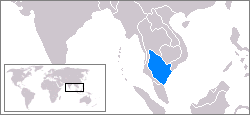Gulf of Thailand
Gulf of Thailand
The Gulf of Thailand, formerly known as the Gulf of Siam, is a shallow inlet in the western part of the South China Sea, bounded by the coastlines of Thailand, Cambodia, Vietnam, and Malaysia. It is a significant body of water that plays a crucial role in the regional geography, economy, and environment of Southeast Asia.
Geography[edit | edit source]
The Gulf covers roughly 320,000 square kilometers (123,553 square miles) and is characterized by its shallow depths, with an average depth of 45 meters (148 feet) and a maximum depth of around 80 meters (262 feet). The Chao Phraya River, Mae Klong River, and Bang Pakong River are among the major rivers that discharge into the Gulf, contributing to its low salinity levels near the river mouths and affecting its marine ecosystems.
The northern tip of the Gulf is marked by the Bangkok Bay, near the capital city of Thailand, Bangkok. The Gulf's coastline is dotted with important ports, including Bangkok Port, Laem Chabang, and Sattahip in Thailand, as well as Sihanoukville in Cambodia. The Gulf's eastern boundary is formed by the South China Sea, and it is connected to the Andaman Sea to the west via the Kra Isthmus and the Kra Canal proposal, which has been a subject of discussion for enhancing maritime trade routes.
Economy[edit | edit source]
The Gulf of Thailand is rich in natural resources, including significant reserves of petroleum and natural gas, making it an important area for Thailand's energy sector. Fishing also plays a vital role in the local economy, with the Gulf's waters supporting a diverse range of marine life. However, overfishing and environmental degradation pose challenges to sustainable development.
Tourism is another economic pillar, with the Gulf's picturesque islands and beaches attracting millions of visitors annually. Notable tourist destinations include Ko Samui, Ko Pha Ngan, Pattaya, and Hua Hin, offering a mix of natural beauty, cultural experiences, and recreational activities.
Environmental Concerns[edit | edit source]
The Gulf of Thailand faces several environmental challenges, including pollution from industrial and agricultural runoff, habitat destruction, and the impacts of climate change such as sea-level rise and increased frequency of extreme weather events. Efforts to address these issues involve both national initiatives and regional cooperation among the Gulf's bordering countries.
Biodiversity[edit | edit source]
The Gulf's ecosystems are diverse, encompassing mangroves, coral reefs, and seagrass beds, which provide critical habitats for a wide array of species. These include endangered marine turtles, dolphins, and numerous fish species. Conservation efforts are crucial to protect these habitats and ensure the Gulf's ecological health and resilience.
Conclusion[edit | edit source]
The Gulf of Thailand is a vital component of Southeast Asia's natural environment and economy. Its management and conservation require collaborative efforts to balance development with environmental sustainability, ensuring it remains a valuable resource for future generations.
Search WikiMD
Ad.Tired of being Overweight? Try W8MD's NYC physician weight loss.
Semaglutide (Ozempic / Wegovy and Tirzepatide (Mounjaro / Zepbound) available. Call 718 946 5500.
Advertise on WikiMD
|
WikiMD's Wellness Encyclopedia |
| Let Food Be Thy Medicine Medicine Thy Food - Hippocrates |
Translate this page: - East Asian
中文,
日本,
한국어,
South Asian
हिन्दी,
தமிழ்,
తెలుగు,
Urdu,
ಕನ್ನಡ,
Southeast Asian
Indonesian,
Vietnamese,
Thai,
မြန်မာဘာသာ,
বাংলা
European
español,
Deutsch,
français,
Greek,
português do Brasil,
polski,
română,
русский,
Nederlands,
norsk,
svenska,
suomi,
Italian
Middle Eastern & African
عربى,
Turkish,
Persian,
Hebrew,
Afrikaans,
isiZulu,
Kiswahili,
Other
Bulgarian,
Hungarian,
Czech,
Swedish,
മലയാളം,
मराठी,
ਪੰਜਾਬੀ,
ગુજરાતી,
Portuguese,
Ukrainian
Medical Disclaimer: WikiMD is not a substitute for professional medical advice. The information on WikiMD is provided as an information resource only, may be incorrect, outdated or misleading, and is not to be used or relied on for any diagnostic or treatment purposes. Please consult your health care provider before making any healthcare decisions or for guidance about a specific medical condition. WikiMD expressly disclaims responsibility, and shall have no liability, for any damages, loss, injury, or liability whatsoever suffered as a result of your reliance on the information contained in this site. By visiting this site you agree to the foregoing terms and conditions, which may from time to time be changed or supplemented by WikiMD. If you do not agree to the foregoing terms and conditions, you should not enter or use this site. See full disclaimer.
Credits:Most images are courtesy of Wikimedia commons, and templates, categories Wikipedia, licensed under CC BY SA or similar.
Contributors: Prab R. Tumpati, MD




